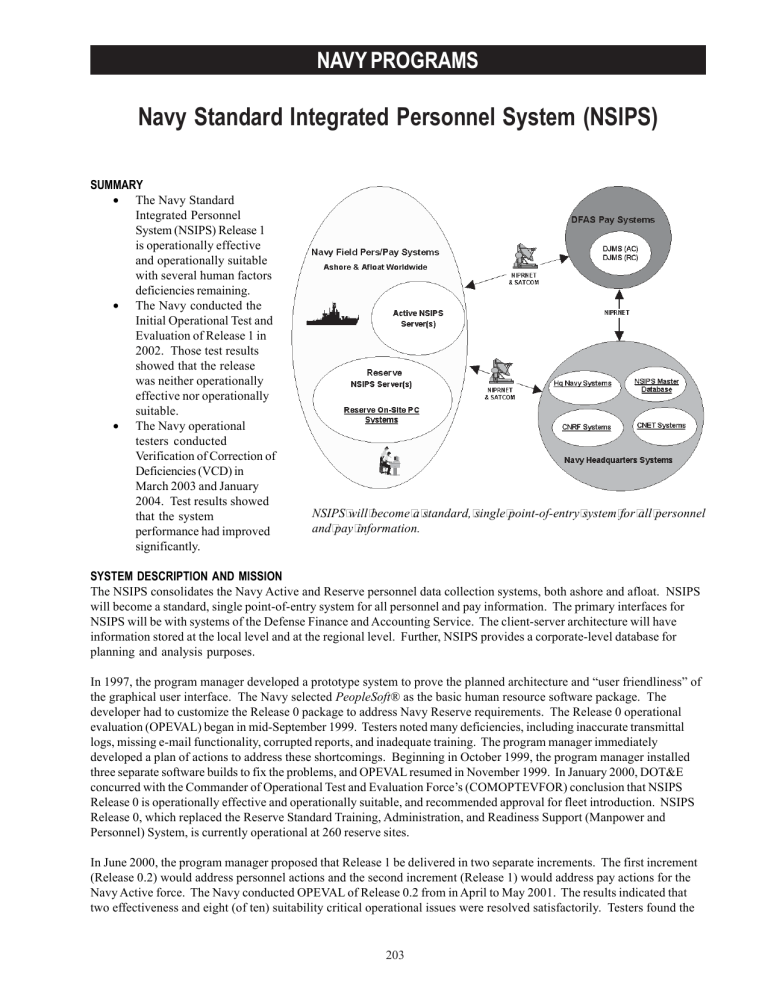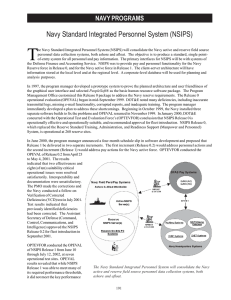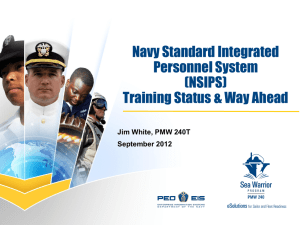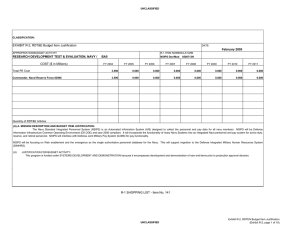Navy Standard Integrated Personnel System (NSIPS) NAVY PROGRAMS

NAVY PROGRAMS
Navy Standard Integrated Personnel System (NSIPS)
SUMMARY
• The Navy Standard
Integrated Personnel
System (NSIPS) Release 1 is operationally effective and operationally suitable with several human factors deficiencies remaining.
• The Navy conducted the
Initial Operational Test and
Evaluation of Release 1 in
2002. Those test results showed that the release was neither operationally effective nor operationally suitable.
• The Navy operational testers conducted
Verification of Correction of
Deficiencies (VCD) in
March 2003 and January
2004. Test results showed that the system performance had improved significantly.
NSIPS will become a standard, single point-of-entry system for all personnel and pay information.
SYSTEM DESCRIPTION AND MISSION
The NSIPS consolidates the Navy Active and Reserve personnel data collection systems, both ashore and afloat. NSIPS will become a standard, single point-of-entry system for all personnel and pay information. The primary interfaces for
NSIPS will be with systems of the Defense Finance and Accounting Service. The client-server architecture will have information stored at the local level and at the regional level. Further, NSIPS provides a corporate-level database for planning and analysis purposes.
In 1997, the program manager developed a prototype system to prove the planned architecture and “user friendliness” of the graphical user interface. The Navy selected PeopleSoft ® as the basic human resource software package. The developer had to customize the Release 0 package to address Navy Reserve requirements. The Release 0 operational evaluation (OPEVAL) began in mid-September 1999. Testers noted many deficiencies, including inaccurate transmittal logs, missing e-mail functionality, corrupted reports, and inadequate training. The program manager immediately developed a plan of actions to address these shortcomings. Beginning in October 1999, the program manager installed three separate software builds to fix the problems, and OPEVAL resumed in November 1999. In January 2000, DOT&E concurred with the Commander of Operational Test and Evaluation Force’s (COMOPTEVFOR) conclusion that NSIPS
Release 0 is operationally effective and operationally suitable, and recommended approval for fleet introduction. NSIPS
Release 0, which replaced the Reserve Standard Training, Administration, and Readiness Support (Manpower and
Personnel) System, is currently operational at 260 reserve sites.
In June 2000, the program manager proposed that Release 1 be delivered in two separate increments. The first increment
(Release 0.2) would address personnel actions and the second increment (Release 1) would address pay actions for the
Navy Active force. The Navy conducted OPEVAL of Release 0.2 from in April to May 2001. The results indicated that two effectiveness and eight (of ten) suitability critical operational issues were resolved satisfactorily. Testers found the
203
NAVY PROGRAMS
interoperability and documentation areas unsatisfactory. The program manager subsequently made corrections and the
Navy conducted a VCD in July 2001. Test results indicated that the program manager had corrected the previously identified deficiencies. DoD approved NSIPS Release 0.2 for fleet introduction in September 2001.
COMOPTEVFOR conducted the OPEVAL of NSIPS Release 1 in June and July 2002 at seven operational test sites.
OPEVAL results revealed that, while NSIPS Release 1 was able to meet many of its required performance thresholds, it did not meet the key performance parameter of 98 percent accuracy in processing personnel or pay transactions (NSIPS achieved only 89 percent accuracy). Of the 13 external system interfaces, the Joint Interoperability Test Command certified only six as interoperable. Because of these and other deficiencies, COMOPTEVFOR considered NSIPS
Release 1 not operationally effective and not operationally suitable for fleet introduction. DOT&E concurred and required a VCD to confirm corrections to the identified deficiencies.
TEST AND EVALUATION ACTIVITY
On March 10-19, 2003, COMOPTEVFOR conducted a VCD at Personnel Support Detachment (PSD) Newport, Rhode
Island, PSD RTC Great Lakes, PSD Guam, and PSD Point Loma, California to verify the corrections. Test results showed that while the system was operationally effective, it was not operationally suitable. In January 2004, COMOPTEVFOR conducted another VCD to verify corrections to the remaining problems.
TEST AND EVALUATION ASSESSMENT
The January 2004 VCD results indicated that the developer had rectified all previously identified deficiencies, but some human factors deficiencies remained. Several of these human factors deficiencies are associated with Navy policies. For example, NSIPS Release 1 does not allow for assisting customers other than those assigned to the command, and does not provide flexibility when assisting reservists and officer accessions (for security and information integrity reasons).
Further, NSIPS halts order processing upon encountering errors and it does not allow PSD to correct erroneous data without intervention from the Navy Bureau of Personnel. Other human factors deficiencies identified were report formatting and dependent data entry. DOT&E recommended that the program manager work with the functional proponent to review existing Navy policies with regard to assisting customers not assigned to the command and providing more flexible support to reservists and officer accessions.
204







